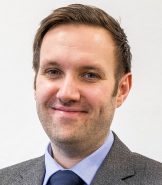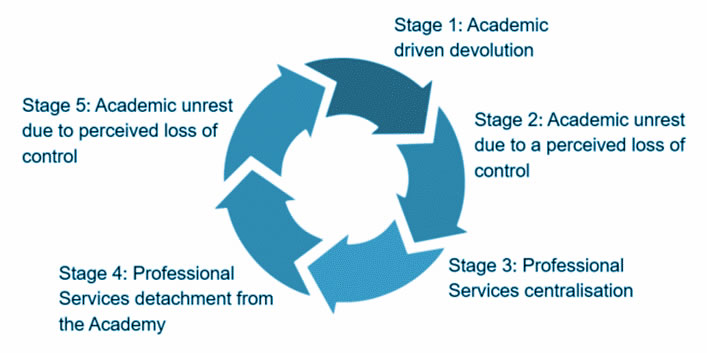 Ian Tidmarsh FIScT CSci has been employed by four universities and has acted as an organisational structure consultant to many more. Through his own experiences, conversations and observations, Ian shares his personal reflections on university operating models.The various stages traversed in pursuit of the optimal model are described in this article.
Ian Tidmarsh FIScT CSci has been employed by four universities and has acted as an organisational structure consultant to many more. Through his own experiences, conversations and observations, Ian shares his personal reflections on university operating models.The various stages traversed in pursuit of the optimal model are described in this article.
This article represents a personal perspective from Ian.
The HEI Trinity – Teaching, Research and Control
University life revolves around three pillars:
- Enhancing Teaching: Teaching usually underpins university financial health. Regulation via increased metrics have refocused the institutional lens;
- Growing world-leading Research: Sometimes preferred by academic colleagues, research (and more widely RKE) aids academic recruitment, delivers breadth, can enhance teaching and is an additional income source;
- Reorganisation of the university’s structure: The change cycle, the focus of this article.
This article shares reflections on the different organisational structures that can exist at universities and the transitional stages that come together to form a cycle of change.
The Cycle
The Cycle is an interpretation of the stages a university moves through in order to organise and reorganise in search of the perfect organisational structure. The changes are in terms of academic and professional services organisational structures and where the decision making authority resides. The Cycle has five stages:
- The Academy (the academic body) drives decision making, often at a local level. There is localised emergent change (devolution) aligned to levels of influence and varying local academic agendas;
- The Academy realises that it requires a greater degree of equity across the institution and enhanced professional support (or external factors drive efficiency savings). Irrespective of the drivers, centralisation of support services is viewed as the solution;
- Professional Services centralise and become more influential and drive decision making;
- Professional Services increasingly look inwards and deviate from the core needs of the Academy. The Academy feels that requirements are not being met and that a misalignment of resources exists;
- The Academy seeks to re-steer and to obtain greater influence and control (a type of devolution occurs).

Each stage is defined below from the perspective of the experience of each staffing group.
Stage 1: In this stage academic colleagues feel empowered and in control. With time, local academic leadership drives divergent local agendas which can result in inconsistency across the institution. To sustain academic growth, central Professional Services funding is reallocated, reducing central capacity. The experiences of individual members of the Academy become heavily dependent on their own level of influence and locality; feelings of inconsistency and unfairness grow. The experiences of Professional Services colleagues are also heavily dependent on locations and local working conditions.
Stage 2: Frustration mounts within the Academy as academic colleagues feel that there is inequality across the academic community. An enhanced Professional Services offering is considered a viable way to reintroduce central support services with consistency and fairness. Opposing academic colleagues may be persuaded that greater ‘centralisation’ yields efficiencies. Some Professional Services colleagues receive criticism for their handling of university affairs.
Stage 3: Professional Services centralise and become more influential in decision making. Academic colleagues feel that their concerns have been heard and that the new centralised structure will deliver. With new Professional Services appointments comes strong professional leadership. Professional Services colleagues are now empowered, feel connected to the Academy and are positioned to shape and enhance their respective services. Localised redundancies (if required) will have caused distress but strong leadership will have navigated this via a respectful and dignified approach. The Academy is satisfied with the aligned professional support it receives.
Stage 4: Professional Services have grown in size, are well respected and embedded across the institution. However, some Professional Services leaders are steering their functions away from the Academy’s core needs. Within the directorate some senior colleagues are seeking more control and internal power struggles may be reducing output. Frustration grows as academic colleagues feel that their requirements are not being met and their requests for support are unheard. Some Professional Services colleagues realise the direction of travel and seek academic sponsorship for protection.
Stage 5: In this final stage, the Academy seeks to re-establish the status-quo. A type of devolution is believed to be the best way to ensure academic colleagues have sufficient local influence and decision making authority to realign Professional Services activity. Strong academic leadership is required to navigate to a successful conclusion; confidence in some Professional Service leaders has reduced and colleagues have become disempowered.
Origins
The cycle relies on either the Academy or Professional Services losing sight of the bigger picture. The cycle appears to continue in perpetuity at some institutions. It is shaped by the leaders, their experiences, their backgrounds, their ambition, and pivotally their ability to maintain the status quo. There is a very favourable middle-ground, but conflicting agendas make this difficult to sustain. Although usually a slowly evolving cycle, events can accelerate due to internal and external factors, if key advocates leave or if very strong leadership is hired. Invariably, the time taken to move through the various stages depends on the ripeness of the conditions required for dissatisfaction. The pandemic appears to be promoting increased change within the sector; this will, either now or in the very near future prompt organisational change.
